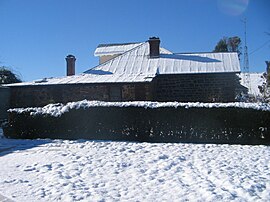Taralga, New South Wales
|
Taralga New South Wales |
|||||||
|---|---|---|---|---|---|---|---|

Beautiful basalt house after snowfall
|
|||||||
| Coordinates | 34°23′0″S 149°49′0″E / 34.38333°S 149.81667°ECoordinates: 34°23′0″S 149°49′0″E / 34.38333°S 149.81667°E | ||||||
| Population | 285 (2011 census) | ||||||
| Postcode(s) | 2580 | ||||||
| Elevation | 845 m (2,772 ft) | ||||||
| LGA(s) | Upper Lachlan Shire | ||||||
| State electorate(s) | Goulburn | ||||||
| Federal Division(s) | Hume | ||||||
|
|||||||
Taralga is a small village in the Southern Tablelands of New South Wales, Australia in Upper Lachlan Shire. It is located at the intersection of the Goulburn-Oberon Road and the Laggan-Taralga Road. It is accessible from Oberon to the north, Mittagong to the east, Goulburn to the south, and Crookwell to the west. At the 2011 census, Taralga had a population of 285 people. The exact origin of the name Taralga is disputed. The two most widely supported theories are that the village was originally known as "Trial Gang" as within the early colonial boundaries of Argyle County, it was a location for the trials of convicts and bushrangers before the Crown. The second theory is that Taralga means "native companion" in the language of the Burra Aboriginal people. Taralga is located relatively close to the famous Wombeyan Caves. The town experiences a mild climate and is frequently affected by snow in the winter months.
The population of Taralga has fluctuated over time reflecting the town's fortunes. There were approximately 100 residents in 1863, growing to over 700 by the 1890s. Immediately after the depression of the 1890s, the population shrank to half this size, but recovered by mid the 1950s almost to its peak level. Today the town and surrounds service around 400 people.
The area around Taralga was the traditional land of the Burra Burra peoples, a warlike tribe who often clashed with neighbouring tribes and never lost a fight. Although no major clashes with the Europeans seem to have been recorded, nor tales of collaboration with them, their last great gathering or corroboree seems to have been in the 1830s after which they are not recorded by European history. Accordingly, they would have been pushed further west to less fertile plains after the disease brought by the Europeans.
...
Wikipedia

